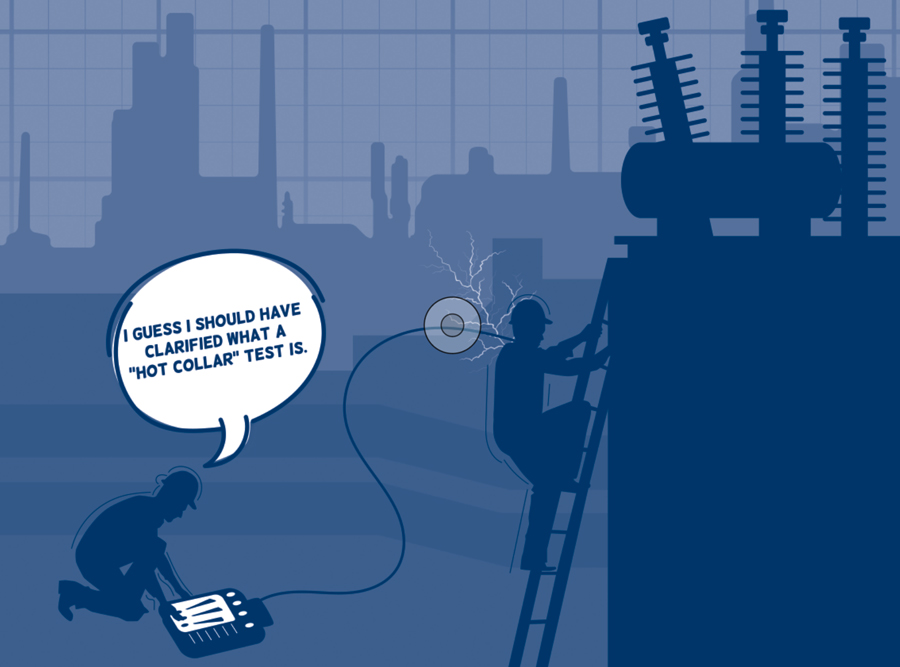It’s very exciting to kick off the first “In the Field” column. Consistent with this NETA World edition’s theme, an article on communications seemed fitting. As I write this, I realize I assumed the “communications” theme was related to interpersonal communications, but I didn’t communicate well enough to clarify that the theme is probably related to equipment communications such as electronic communication protocols using for metering networks or SCADA. Oh well, I’m just going to push forward and keep writing. Plus technician communications skills have been ignored for much too long.
I used the term interpersonal communication as I understood it, but a quick internet search to ensure I’m not way off provided a very good definition that ties in perfectly to my intended article discussion points. See the following from www.skillsyouneed.com.
“Interpersonal communication is the process by which people exchange information, feelings, and meaning through verbal and non-verbal messages: It is face-to-face communication. Interpersonal communication is not just about what is actually said — the language used — but how it is said and the non-verbal messages sent through tone of voice, facial expressions, gestures, and body language.”
Types of Communications
How do we communicate? Most ways I can think of are listed below.
Verbal: Face-to-Face, Phone, Video
Face-to-face is the most effective method. I think that’s because we can look at others, have their full attention (unless they have a cell phone in their hands), and see their facial expressions and body language. Video might then be second, but this platform’s potential hasn’t been realized.
Phone communications are common and can explain a more complex issue easier than its sometimes-laborious written counterpart. Phone communications can also open the door to getting both parties on the same page toward finding common ground, such as in negotiations, and it often is easier than email negotiations that can quickly become confrontational with finger-pointing.
Written: Letter, Email, Text, Fax, Sign, Label
Letters only contain bad news — bills and lawsuits — but can make an impact on the recipient. The fax is now almost extinct with the advent of email. Everyone seems to love email, and it has made communication much easier, plus we can now mostly ignore these communications if we want to. We can respond when time allows based on urgency, which in some cases is not at all. Email communications are so effective that advertising campaigns cannot exist without them. However, this mode of communications can be abused as in the case of spam, and email wording can be misconstrued and result in unnecessary hard feelings.
One of the best written communication tools for the technician, next to the test data sheet, is the job hazard assessment (JHA) form, as it makes us carefully think about what we are doing and how to do it safely. It also requires us to sign the document, which adds an additional element of importance and thought to ensuring the task we are about to embark upon is performed safely.
Body Language, Sign Language
The study and interpretation of body language is a fascinating subject. It has been said these observations can provide insight into what a person is really thinking. Instead of studying this technique, most of us can just get a feel about how someone’s body language provides clues to their actual inner thoughts.
Sign language, which is primarily a means of communications for the hearing impaired, has evolved to help many people communicate. For example, the signals communicated among crane operating crews are another form of effective sign language communications, but we may also have witnessed a less-effective use of sign language by a traffic cop thrusting his arms in various directions. Their efforts sometimes seem to create more congestion and confusion than would otherwise be expected.
Communications for Technicians
Communication is extremely important for the test technician. Our lives are on the line, and miscommunication can lead to an extremely dangerous situation. Communications must be clear and concise. We must be quick to state the answer and only provide brief clarification — not tell a story.
We must also realize that communications are a two-way street. If not precisely sure what you are being told, just ask (verify). The cartoon displays — in a humorous way — how a simple verbal miscommunication could result in a mishap.

Mini Case Studies
• A utility outage occurred at a major downtown building. Communication with the utility was made between our foreman through the building engineer. We disliked this situation because the utility was remote, and they did not allow us to apply our lock to their equipment. Near the end of the outage, a miscommunication between the foreman and the utility caused the line side of the main to be energized. Although an incident did not occur, this miscommunication could have easily resulted in injury or death. It was a surprise we won’t forget.
• A similar incident occurred while performing an acceptance ground fault interrupter (GFI) test on a switchboard at a large retail store. While setting up for the test, the foreman went outside to the utility personnel who were working on the pad-mount transformer feeding the store’s service entrance. Although communication seemed to be clear, the utility surprisingly energized the circuit moments after clearing the safety grounds. Did we tell the wrong man? He didn’t indicate he wasn’t the correct person to inform. Did he simply forget?
• I witnessed two instances where people were accidently locked in an elevator for hours due to miscommunication. A technician was locked in an elevator after the utility performed a maintenance disconnect, even though the foreman told the utility to tell us when they were ready BEFORE shutting down, not after. In a second event, a building engineer was locked in an elevator under similar circumstances. He was confident the elevator circuit would be on the automation transfer switch and it should have been.
• Troubleshooting activities can often lead to confusion and miscommunication. In many cases, one must be a detective and keep prying to understand the critical events related to the failure to piece together the puzzle.
• A similar “trust but verify” troubleshooting situation occurred where two competent independent testing teams were thumping the wrong faulted medium-voltage circuit for a couple of days before dismissing the site contact’s incorrect recollection and the incorrect single line drawings and starting the troubleshooting process all over from the beginning.
• Another similar situation occurred — not once but twice — when the responsible cable splicing team conducting the circuit continuity, phase identification, and labeling tasks made labeling errors that caused the testing firm to VLF the wrong circuit. Did they just skip this task because they didn’t understand the importance of the task? Were they untrained to perform the task? Did they merely get confused when applying the label?
• I once texted our project manager, “do you read?” to ensure he got my message. The next day, he seemed upset until I learned he thought I meant “can’t you read” when I actually meant “do you read me?” to have him verify he got my message. We both got a laugh out of it in the end.
• Project specification wording can often lead to controversy. Words with similar meanings can be misinterpreted. “Test” vs. “Set.” “Set” vs. “Calibrate.” “Verify settings” vs. “Set.” Has anyone ever got been caught up in SEL programming vs. setting? That could be an article in itself.
• Even written communication can be difficult in an examination setting. Anyone taking the NETA exam or any other exam can be faced with determining exactly what the question writer is trying to convey. This question seems too easy. Is this a trick question?
Should I read this question over again?
• Finally, just today, we sent a colleague to the store to pick up some simple breakfast items for a small office celebration. The list included juices, breakfast sandwiches, pastries, and muffins. The person providing the instructions envisioned breakfast muffins such as blueberry or banana. He was surprised to be handed a bag of English muffins. The end result of this miscommunication was a laugh or two and another trip to the store.
Final Words
Although we can thankfully be amused by some of these events, we cannot discount the possibility that disaster could easily have been the outcome of these “In the Field” situations, except for the muffins, of course! I actually like English muffins.
The majority of these events occurred because of miscommunications, assumptions, failure to verify, and even forgetfulness. The challenge facing the technician is to avoid these events. Safety procedures such as lock out/tag out (LOTO) and JHA are extremely important and can help prevent major events from occurring. Understanding the entire task process and the various interfaces with other equipment and other personnel along with concise communications will also help greatly.
So long for now. I really hope we get some good war-story articles from our technicians out there.
References
Don A. Genutis. “No Outage Corner: First Rule of Troubleshooting: Trust but Verify.” NETA World, Winter 2016.
Don A. Genutis. “No Outage Corner: What’s in a Sign?” NETA World, Winter 2017.
 Don A. Genutis presently serves as President of Halco Testing Services, Inc., a NETA Accredited Company with offices in Los Angeles and Houston. He has held various principal positions during his 35-plus year career in the electrical testing field, primarily focused on advancing no-outage testing techniques for the last 20 years, with emphasis on cable and switchgear on-line partial discharge testing techniques. Early in his career, Don acquired and operated the former Westinghouse East Pittsburgh Insulation Research Laboratory, where he gained valuable experience in the understanding of insulation material performance. Don holds a BS in electrical engineering from Carnegie Mellon University and is a NETA Certified Technician. Don has authored 50 technical articles for NETA World and has been featured in EC&M and Uptime magazines. Don’s work is summarized in his book, Partial Discharge & Other No-Outage Testing Methods, published in 2019.
Don A. Genutis presently serves as President of Halco Testing Services, Inc., a NETA Accredited Company with offices in Los Angeles and Houston. He has held various principal positions during his 35-plus year career in the electrical testing field, primarily focused on advancing no-outage testing techniques for the last 20 years, with emphasis on cable and switchgear on-line partial discharge testing techniques. Early in his career, Don acquired and operated the former Westinghouse East Pittsburgh Insulation Research Laboratory, where he gained valuable experience in the understanding of insulation material performance. Don holds a BS in electrical engineering from Carnegie Mellon University and is a NETA Certified Technician. Don has authored 50 technical articles for NETA World and has been featured in EC&M and Uptime magazines. Don’s work is summarized in his book, Partial Discharge & Other No-Outage Testing Methods, published in 2019.
